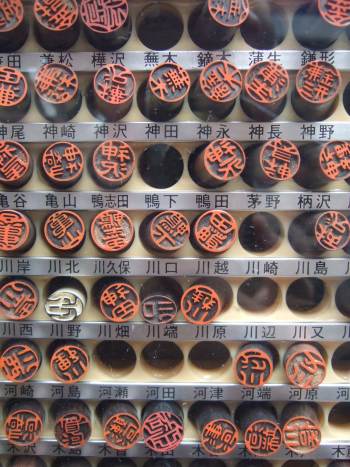
 |
| Seals in a shop display |
|---|
| Photo credit: David Ooms / CC licence |
The Japanese do not use signatures. Instead, they use seals with the person's name in kanji. The stamps are called hanko (判子) or inkan (印鑑) and are made of wood, ivory, or plastic.
The usual seal, the mitomein (認印), is used for registered mail and so on in place of a signature. A type of mitomein is the ginkōin (銀行印) which is used for bank accounts. This must have the same name as the person's full name or family name.
Jitsuin (実印) are used for purchases such as houses or cars. The seal must be registered as a tōroku inkan (登録印鑑) at the local government offices, yakusho (役所) or yakuba (役場).
The red ink used is called shuniku (朱肉), and at banks and post offices there are red stamp pads on counters. Because hanko are used, most documents do not have a signature line, but rather a small circle with a single character in (印) where the seal is to be pressed.
In most cases, foreigners in Japan can get away with using their signature rather than a seal.
In Japanese, a "seal" or shiiru (シール) means a "sticker" rather than a seal, and a signature is called a sain (サイン). See What "false friends" are there between Japanese and English?
Copyright © 1994-2025 Ben Bullock
If you have questions, corrections, or comments, please contact Ben Bullock or use the discussion forum / Privacy policy

|

|

|

|

|
| Book reviews |
Convert Japanese numbers |
Handwritten kanji recognition |
Stroke order diagrams |
Convert Japanese units |